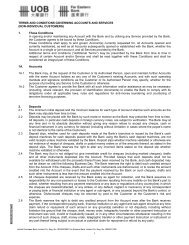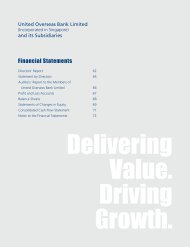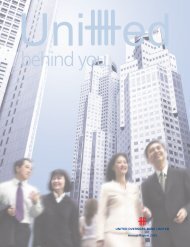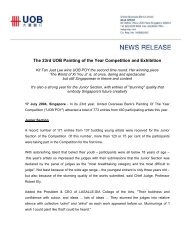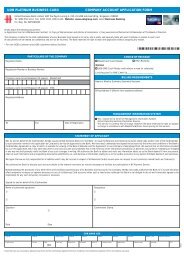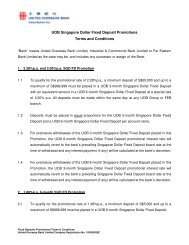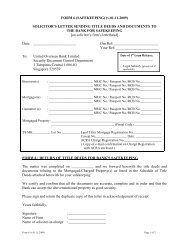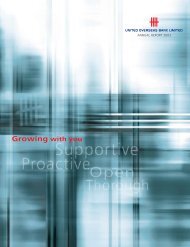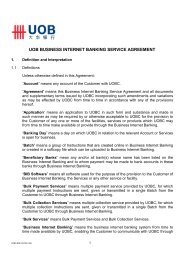UOB Annual Report 2002 - United Overseas Bank
UOB Annual Report 2002 - United Overseas Bank
UOB Annual Report 2002 - United Overseas Bank
Create successful ePaper yourself
Turn your PDF publications into a flip-book with our unique Google optimized e-Paper software.
Risk Management<br />
Market Risk Management<br />
Market risk is defined as the potential loss in market value of a given portfolio that can be expected<br />
to be incurred arising from changes in market prices, namely, interest rates, foreign exchange rates,<br />
equity prices and option volatility relating to all the above rates or prices.<br />
The Group is exposed to market risk in its trading portfolio because the values of its trading<br />
positions are sensitive to changes in market prices and rates.<br />
Market risk is managed using a framework of market risk management policies and risk control<br />
procedures, as well as notional, greeks, risk and loss limits. These limits are proposed by every<br />
trading desk/division (including the Group's overseas operations), reviewed by Risk Management<br />
& Compliance Sector – Market Risk Management and approved by ALCO annually. ALCO also<br />
reviews and approves new limits or changes to existing limits as and when these are proposed.<br />
The powers of ALCO are delegated by the Executive Committee of the Board whose powers are,<br />
in turn, delegated by the Board of Directors. The monitoring of market risk trading limits and the<br />
reporting of any limit excess and ratification are carried out independently by the Business Area<br />
Control Unit.<br />
There is no single risk statistic that can reflect all aspects of market risk. The most common<br />
approaches are Value-at-Risk (VaR) and stress testing. These risk measures, taken together, provide<br />
a more comprehensive view of market risk exposure than any one of them individually. VaR is a<br />
measure of the dollar amount of potential loss from adverse market movements under a normal<br />
market environment. Statistical models of risk measurement, such as VaR, provide an objective<br />
and independent assessment of how much risk is being taken. They also allow consistent and<br />
comparable measurement of risk across financial products and portfolios.<br />
Market risk is measured using VaR methodologies, namely, variance-covariance and historical<br />
simulation models based on historical market data changes for the past 260 days within a 95%<br />
confidence level and assuming a one-day trading horizon.<br />
The variance-covariance methodology is a parametric approach that assumes that returns are<br />
normally distributed. Under this methodology, a matrix of historical volatilities and correlations is<br />
computed from the past 260 days' market data changes. VaR is then computed by applying these<br />
volatilities and correlations to the current portfolio valued at current price levels.<br />
The historical simulation methodology is a non-parametric approach that does not make any<br />
underlying assumption about the distribution of returns. The method assumes that actual observed<br />
historical changes in market rates, such as interest and foreign exchange rates, reflect future<br />
possible changes. It uses historical price changes for the past 260 days to compute the returns of<br />
the portfolio and a VaR figure is then obtained from the actual distribution of these returns of the<br />
portfolio based on a 95 percentile.<br />
44




